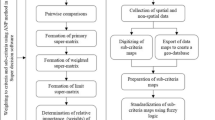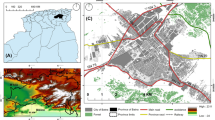Abstract
Today, participation in social investment is a critical concern of urban management in metropolitan areas. To be effective in both public and private sectors, such participation requires an accurate knowledge of geographical distribution of resources and social needs in different parts of the city in order to better manage these investments. To this end, the present research aimed at providing an objective and tangible integrated approach to identify urban neighborhoods with high potential for social investment. The research area was neighborhoods located in Mashhad, Iran. Thirty-one criteria in three dimensions of empowerment, education, and culture were identified. Having determined, normalized, and weighted the values of each criteria in different neighborhoods using the analytic hierarchy process (AHP) method, the weight scores of each neighborhood in each dimension were added up by GIS approach and Arc GIS 10.1 software. Then, in order to conclude the overall status of social investment in different neighborhoods, a fuzzy inference system (FIS) was designed in the MATLAB 2014a environment according to experts’ opinions. Finally, based on the output of the designed system, the overall status of each neighborhood studied was determined in terms of social investment and neighborhoods with high potential for social investment were identified. The approach presented provides an insight for urban mangers, companies, and philanthropic investors to invest more effectively given the appropriate social investment opportunities.







Similar content being viewed by others
References
Attanasi G, Casoria F, Centorrino S, Urso G (2013) Cultural investment, local development and instantaneous social capital: a case study of a gathering festival in the South of Italy. J Socio-Econ 47:228–247
Berry BJL, Marble DF (1968) Spatial analysis: a reader in geography. Prentice- Hall Incorporations, Englewood Cliffs
Bonoli G (2013) The origins of active social policy: labor market and childcare policies in comparative perspective. Oxford University Press, New York
Bouget D, Frazer H, Marlier E, Sabato S, Vanhercke B (2015) Social investment in Europe. A study of national policies. European Commission, Brussels Google Scholar
Cantillon B (2011) The paradox of the social investment state. Growth, employment and poverty in the Lisbon Era’. J Eur Social Policy (forthcoming).
Carley MJ (1981) Social measurement and social indicators: issues of policy and theory. Boston, Mass., George Allen & Unwin, 1981. x, 195 p. (Contemporary Social Research Series, No. 1)
Cutter SL, Finch C (2008) Temporal and spatial changes in social vulnerability to natural hazards. Proc Natl Acad Sci 105(7):2301–2306
Czogala E, Leski J (2000) Fuzzy and neuro-fuzzy intelligent systems, ser. Studies in Fuzziness and Soft Computing. Springer, 47
Esping-Andersen G (2002) A child-centered social investment strategy. In: Esping-Andersen G, Gallie D, Hemerijck A, Meyers J (eds) Why we need a new welfare state. Oxford University Press, New York, pp 26–67
Flanagan BE, Gregory EW, Hallisey EJ, Heitgerd JL, Lewis B (2011) A social vulnerability index for disaster management. J Homeland Security Emergency Manag 8(1):1–22
Foong KC, Chee CT, Wei LS (2009) Adaptive network fuzzy inference system (ANFIS) hand off algorithm. Int J Netw Mobile Technol 1(2):54–59
Goodchild MF (1988) A spatial geographical perspective on GIS. Int J Geogr Inf Syst 1:327–334
Hagerstrand T (1985). Time-geography: focus on the corporeality of man, society, and environment. New York:United Nations Univ
Johnston RJ (1994) Spatial analysis. In: Johnston RJ, Gregory D, Smith DM (eds) The Dictionary of Human Geography. Blackwell, Oxford
Kanbur R, Venables AJ (2005) Spatial inequality and developement overview of UNU-WIDER project. Working Papers 127127, Cornell University, Department of Applied Economics and Management
Kia SM (2011) Fuzzy inference in MATLAB. Kianpub, Tehran
Mamdani EH, Assilian S (1975) An experimental in linguistic synthesis with a fuzzy logic controller. Int J Man-Machine Stud 7(1):1–13
Martines MR, Toppa RH, Ferreira RV, Cavagis A, Kawakubo FS, Morato RG (2017) Spatial analysis to identify urban areas with higher potential for social investment. J Geogr Inf Syst 9(5):591–603
Mashhad city statistical yearbook (2016-2017). Bureau of statistics, research and strategic studies
McEwin M (1995) Social indicators and social statistics in Australia. Stat J U N Econ Comm Eur 12(3-4):309–318
Midgley J (1999) Growth, redistribution and welfare: towards social investment. Soc Serv Rev 77(1):3–21
Midgley J (2017) Social welfare for a global era: international perspectives on policy and practice. Sage Publications, Los Angeles
Miles I (1985) Social indicators for human development. United Nations University
Morel N, Palier B, Palme J (2012) Towards a Social Investment Welfare State? Ideas, Policies and Challenges. Policy Press
Otieno OD (2016) Role of educational investment on economic growth and development in Kenya. J Educ Pract 7(22):68–81
Pattison WD (1963) The four traditions of geography. J Geogr 36:166–161
Rufat SE, Burton CG, Maroof AS (2015) Social vulnerability to floods: review of case studies and implications for measurement. Int J Disaster Risk Reduct 14(Part 4):470–486
Saaty TL (1980) The analytic hierarchy process. McGraw-Hill, New York
Statistics of Mashhad City (2016). Mashhad: Mashhad municipality
Thapa RB, Murayama Y (2010) Drivers of urban growth in the Kathmandu valley, Nepal: examining the efficacy of the analytic hierarchy process. Appl Geogr 30:70–83
Titz A, Cannon T, Krüger F (2018) Uncovering ‘community’: challenging an elusive concept in development and disaster related work. Societies 8(3):1–28
Trondheim RJ (2002) Reducing disaster vulnerability through local knowledge and capacity. Thesis, Norwegian University, Department of Town and Regional Planning
Twigg J (2001) Sustainable livelihoods and vulnerability to disasters, Benfield Greig hazard Center, for the Disaster Mitigation Institute (DMI)
Uricchio VF, Giordano R, Lopez N (2004) A fuzzy knowledge-based decision support system for groundwater pollution risk evaluation. J Environ Manag 73(3):189–197
Wisner B (1998) Marginality and vulnerability; why the homeless of Tokyo don’t ‘count’ in disaster preparations. Appl Geogr 18(I):2.5–33
Wisner B, Blaikie P, Cannon T, Davis I (2004) At risk: natural hazards, people’s vulnerability and disasters. Routledge, London
Yoon DK (2012) Assessment of social vulnerability to natural disasters: a comparative study. Nat Hazards 63(2):823–843
Zadeh LA (1965) Fuzzy sets. Inf Control 8(3):338–353
Author information
Authors and Affiliations
Corresponding author
Rights and permissions
About this article
Cite this article
Aghajani, H., Alizadeh-Zoeram, A. Identifying urban neighborhoods with higher potential for social investment using GIS-FIS approach. Appl Geomat 13, 1–13 (2021). https://doi.org/10.1007/s12518-020-00317-4
Received:
Accepted:
Published:
Issue Date:
DOI: https://doi.org/10.1007/s12518-020-00317-4




